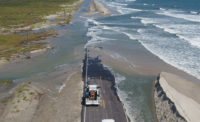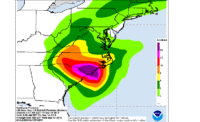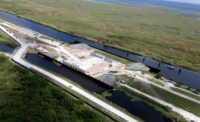As first responders continued search and rescue operations one day after Hurricane Ida came ashore Aug. 29 in Louisiana as a Category 4 hurricane, with sustained winds of 150 miles per hour and higher, the state began the long task of assessing the storm damage—from Port Fourchon, La., which handles 18% of U.S. offshore oil traffic to New Orleans, the state capital in Baton Rouge and the state's northern border.
“The next several days and weeks will not be easy,” Louisiana Gov. John Bel Edwards (D) said during an afternoon press conference Aug. 30.
New Orleans Mayor LaToya Cantrell said there was no widespread major destruction in the city and no reports of of massive loss of life. There were 18 water system outages impacting more than 312,000 people, and 14 boil-water advisories affecting more than 329,000 people across Louisiana, Edwards said Aug. 30.
The region's power grid took the storm's major blow, largely from the impact of high winds. More than 47% of Louisiana homes were without power as of the morning of Aug. 30, according to the US Dept. of Energy.
[Read more about Ida's impacts to Louisiana's power grid here]
Structural assessments of the worst hit areas, such as Port Fourchon and Grand Isle, where Ida came ashore, were still ongoing. U.S. Rep. Garrett Graves (R), who represents south Louisiana, flew over the port and took a photo of the seemingly leveled port facility.
Levee System Holds Up
By all reports, the $14.6-billion Hurricane and Storm Damage Risk Reduction System, built after Hurricane Katrina in 2005, prevented the New Orleans metropolitan region from flooding.
“The hard structures held up. The pump stations held up and they did their part," says Wayne E. Jones, project manager at Traylor Bros, involved in the structure's construction. "It’s the soft structures outside the perimeter storm surge defenses that took the hit, but they did provide a great benefit to protect everything else.”
Jones planned and executed construction of the $1-billion Inner Harbor Navigation Channel Storm Surge Barrier in New Orleans, part of the hurricane risk and reduction system. He received ENR's 2013 Award of Excellence for his leadership on that project.
Matt Roe, US Army Corps of Engineers' New Orleans district spokesman, says there were no reports of any levee overtopping in the New Orleans area.
“The system performed as designed during the event," he said. "Locally, our immediate focus is that as soon as it is safe to do so, we will have boots on the ground and experts in the air to assess any damages that may have occurred during the storm."
But for areas outside the federal protection system—including the municipalities of Lafitte, LaPlace and Houma—Ida brought devastating flooding. The storm comes just one month after construction began on a $760-million federal levee project designed to protect the vulnerable east bank of St. Charles, St. James and St. John the Baptist parishes.
"Near LaPlace [in St. John Parish], they had a lot of flooding, but it’s not an area that is protected very well," says Lewis “Ed” Link, a University of Maryland senior research engineering professor who helped guide work on the new levee project. Link was ENR's 2007 Award of Excellence winner for his work on the failure analysis following Katrina.
Levee officials said every inch of the system will be inspected.
Much Transportation Spared
Ida appears to have spared the region’s major transportation infrastructure, although sections of Interstate 10 and other major roadways in and around New Orleans remain closed as a result of high water, fallen trees, debris and downed power lines. In LaPlace, I-10 was beneath 4 ft of water, according to the state Dept. of Transportation and Development. In Mississippi, flooding, sand over-wash and debris closed a 29-mile coastal stretch of U.S. Route 90 between Biloxi and Bay St. Louis.
South of New Orleans, high water and debris also closed several roads connecting Jefferson Parish’s most remote communities, including Grand Isle, at the southernmost end of State Route 1. Parish officials also reported that a barge impact had structurally compromised a 522-ft-long swing bridge spanning Bayou Barataria, isolating dozens of residents in adjacent communities.
In Chalmette, east of New Orleans, the status of up to 22 barges reported to be loose in the Mississippi River during Ida’s peak remained unknown as of the afternoon of Aug. 30. The New Orleans Regional Transit Authority also reported two passenger ferries that broke free of their moorings Sunday night had run aground.
Assessing Refineries and Pipelines
The US Dept. of Energy said several pipelines shut down operations in advance of the storm as part of standard precautions. Colonial Pipeline Lines 1 and 2, which travel from Houston to Greensboro, N.C., were shut on Aug. 29 as part of routine safety measures, the company said..
In addition, at least nine refineries in Louisiana reduced production or shut operations as Ida approached Louisiana. A refinery for oil firm Alliance is located near one of the minor levee failures, but it was unclear as of late on Aug. 30 if that failure impacted the facility
These refineries account for about 2.3 million barrels per day of U.S. refinery capacity, or about 13% of total U.S. operable refining capacity, according to DOE. Production at major chemical and petrochemical complexes, including those of Dow Chemical, ExxonMobil, Formosa Plastics and Westlake Chemical, was also shut ahead of the storm, which energy and industrial analyst S&P Global said could lead to a shortage of plastics for building materials, such as PVC pipe.
“Our members are actively assessing their facilities and infrastructure while monitoring flooding conditions on the ground and ongoing weather reports,” says Suzanne Lemieux, director of operations security and emergency response at the American Petroleum Institute. “Operators will continue coordinating with federal and state authorities to mitigate risks and address any potential disruptions to fuel supply while working to resume supplying the energy that’s critical to emergency response.”
Hospital Roof Damage Is Widespread
Several hospitals, now seeing a resurgence of COVID-19 patients, had varying amounts of damage, with some having to evacuate patients.
Louisiana’s largest hosptal network, Ochsner Health, reported significant roof damage at its partner hospital, Terrebonne General Medical Center in Houma, and at St. Anne Hospital in Raceland and Leonard J. Chabert Medical Center in Houma.
Speaking in an online media briefing on Aug. 30, Ochsner CEO Warner Thomas said teams have already been deployed to put temporary roofing in place.
“I would say probably every facility we have had some sort of roof issue, and we had water intrusion. There were different magnitudes,” Thomas said. Ochsner has about 15 hospitals that were in the storm’s path. “We’re talking about water coming through the roofs, running down walls and coming through windows given the sustained wind. We had a few windows blow in. It’s not like we had catastrophic roof failures, but we certainly had a lot of water.”
Contractors Take Stock of Jobsites
Contractors across southeast Louisiana have been on standby to monitor their jobsites and assess damages.
Ryan Gootee General Contractors in Metairie, La., which has about a dozen jobsites in Orleans Parish, plans to deploy teams to assess those sites as quickly as possible, says spokesman Kristian Sonnier. But a citywide lack of power and critical infrastructure could complicate things.
Sonnier says assessing personal property and personnel safety will be the firm’s first priority. “Our superintendents did a really good job of battening down the hatches before the weather came. But it’s going to take a while to get to those jobsites and assess them,” he says.
Jones says Traylor Bros. also has a project underway in the impacted area to replace a bridge and tunnel system at Belle Chasse. He says construction is at about 15% completion on a new bridge, but the site is already busy with cranes in the canal and on land
“[We] had to tie down and pull out,” he says, and the crew is now scattered from Florida to Texas, which is an experience he thinks is particularly valuable for the younger workers who may not have been through such a storm before. “They need to know to run from the water and hide from the wind,” Jones says.
Communication has been a major concern. With cell service down and power out, many contractors could not gain a good sense of what was going on the day after the storm, says David Helveston, president and CEO of the Pelican Chapter of the Associated Builders and Contractors in Baton Rouge.
“I think the biggest thing for contractors is assessing the situation today and immediately mitigating damage,” he says. Going into the storm, contractors secured their sites, knowing wind would be a major concern, Helveston says.
“Unfortunately, we’re getting all too good at this,” he says. “Contractors in Louisiana know how to quickly get onsite and mitigate damage and begin the long, slow process of rebuilding. And they will do it once again.”









Post a comment to this article
Report Abusive Comment